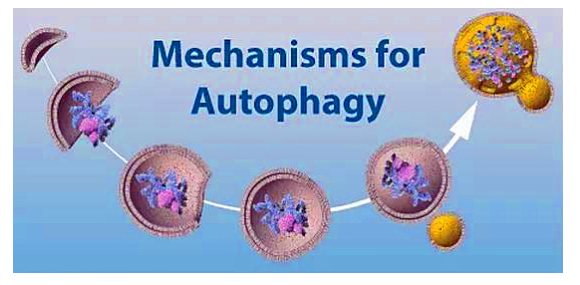LC3- a marker of cell autophagy
The annual Nobel Prize holds as scheduled, and Japanese scientist Yoshinori Ohsumi was awarded this year’s Nobel Prize in Physiology or Medicine, by the discovery of cell autophagy mechanism. In the early 1950s, scientists in Belgium observed autophagic vacuole by electron microscope, and firstly put forward concept of "autophagy".
Autophagy is a process of phagocytosing autologous cytoplasmic proteins or organelles, encapsulating them into vesicles and fusing with lysosomes, degrading the contents of lysosomes to achieve cellular homeostasis and organelle renewal. This procedure ended with a lysosomal closure chamber. Figure 1 graphically depicts the mechanism for autophagy. Generally speaking, cells can provide energy and nutrients by degrading their non-essential components, and they can also degrade some toxic components to prevent cell damage and apoptosis. The current gold standard is to observe the autophagic structure by electron microscopy and detection of autophagy marker - LC3. Although autophagy can be observed directly by electron microscopy, it is more common to detect autophagy marker LC3 because of the demanding equipment of electron microscopy and certain experimental skills. When we have a sufficient understanding of autophagy, it is better to research the physiological process of senescence, cell differentiation and development, immunology, elimination of microorganisms and tumors.

Fig. 1. The pattern of mechanisms for autophagy (cited from Nobelprize.org Database)
LC3 was initially identified as microtubule-associated proteins 1A and 1B, known as MAP1LC3, and was subsequently found to have high similarity to the yeast protein Apg8 / Aut7 / Atg8, and it plays an important role in the autophagy. There are three subtypes of LC3 in mammals, including LC3A, LC3B and LC3C, which are involved in post-translational modifications during autophagy. During the process of autophagy, LC3 protein is cleaved by Atg4 at its carboxyl terminus immediately after synthesis, resulting in the production of cytoplasmic LC3-I protein. LC3-I is modified and processed by ubiquitin-like systems including Atg7 and Atg3 to produce LC3-II, which is located to autophagosomes, and with a molecular weight of 14kD. Thus, LC3 and LC3-II, both present in autophagosomes, are considered to be molecular markers of autophagy, and the content ratio of C3-II / I can be used to estimate the level of autophagy. LC3A, as a kind of LC3, can also be used as a molecular marker for autophagy.
Cloud-Clone Corp. has developed many products aimed at LC3A, including recombinant proteins (RPL701Hu01、RPL701Ra01), antibodies (MAL701Hu21、 MAL701Ra21、PAL701Hu01、PAL701Ra01) and ELISA kits (SEL701Hu、SEL701Ra) for researchers to study the autophagy-related mechanisms.
For more products, please visit: http://www.cloud-clone.us/.


